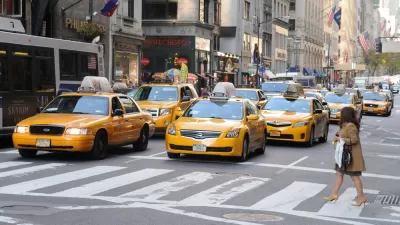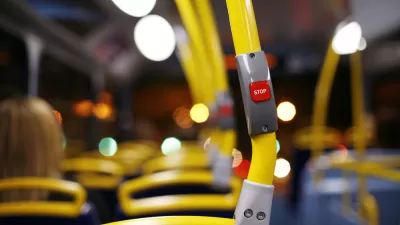A small public transit company serving the East Bay will be the first in California to conduct a pilot project to use transportation network companies and taxis to service low density areas of Dublin in Alameda County.
"One of the great, looming questions of transportation is whether transportation network companies will complement or compete with transit," wrote Planetizen editor James Brasuell last month about "a new uberPool promotion [that] suggests the ride-hailing service may be inching closer to becoming competition for public transit."
Now from the Bay Area comes a promotion for ride hailing services, including taxis for those without smartphones, not from transportation networking companies but from the public transit industry itself. Why, you might ask, would a public transit provider spend precious public funds on the private sector so as to replace or complement its own transit services?
As Christy Wegener, director of planning and communications for the Livermore Amador Valley Transit Authority (called "Wheels") tells Devin Katayama of KQED News, the Bay Area's National Public Radio station, on the audio tape. "Dublin has some 'challenging areas' to service a bus in areas of low-density development which cost the bus agency over $15 for 'big bus service.'"
To make the pilot affordable to participants, "[t]he Livermore Amador Valley Transit Authority has committed $100,000 and has submitted an application for a $100,000 grant from the Alameda County Transportation Commission, said Wegener.
"Fares would be limited to $3 for trips within West Dublin and $5 within the East Dublin project area -- much less than the typical Uber or Lyft fare but more than the $2 Wheels bus fare, according to a report to the valley transit authority," reports Denis Cuff for The Mercury News. Seniors and disabled pay $1 for fixed route service. Dial-A-Ride Paratransit fare is $3.50.
In anticipation of the partnership, Wheels on Aug. 13 eliminated its No. 3 bus route in West Dublin. The route was attracting only about five riders per hour at a public subsidy of $15 per rider, according to the report.
Union opposes pilot
"We object they are using public funds to subcontract with drivers who are independent contractors working for a company that has a bad reputation for how it treats its workers," said Teamster Local 70 spokesman Richard Fierro. "We are not opposed to them finding more cost-effective ways to provide service, but we don't think this is the way to do it."
"Dublin’s population has been one of the fastest growing in Alameda County," states Katayama. [In fact, the city of almost 50,000 in 2013 was the second-fastest growing in the state in 2012, according to the Dublin Patch.]. "Do you think that these partnerships are a long- term fix or a short-term fix to gaps in the public transportation system in the Bay Area suburbs?" he asks Wegener.
I think that it has definite long-term potential. We’re struggling with how do you provide that connectivity to your main line routes, and this is our first attempt to come up with a creative solution.
"[T]he pilot program will continue until the money runs out, which Wegener said could be in a year," adds Katayama.
To return to the original question posed by Brasuell, will TNCs complement or compete with public transit, Wegner states (at the end of the audio tape): "We don't look at this as competitive; we look at this service as a complement to our fixed bus route network."
Last year Eric Jaffe reported for CityLab on how larger cities and transit agencies are dealing with transportation network companies.
Hat tip to L.A. Metro Transportation Headlines.
FULL STORY: Pilot Program to Help Dublin Commuters Pay for Uber, Lyft, Cabs

Planetizen Federal Action Tracker
A weekly monitor of how Trump’s orders and actions are impacting planners and planning in America.

Maui's Vacation Rental Debate Turns Ugly
Verbal attacks, misinformation campaigns and fistfights plague a high-stakes debate to convert thousands of vacation rentals into long-term housing.

San Francisco Suspends Traffic Calming Amidst Record Deaths
Citing “a challenging fiscal landscape,” the city will cease the program on the heels of 42 traffic deaths, including 24 pedestrians.

Amtrak Rolls Out New Orleans to Alabama “Mardi Gras” Train
The new service will operate morning and evening departures between Mobile and New Orleans.

The Subversive Car-Free Guide to Trump's Great American Road Trip
Car-free ways to access Chicagoland’s best tourist attractions.

San Antonio and Austin are Fusing Into one Massive Megaregion
The region spanning the two central Texas cities is growing fast, posing challenges for local infrastructure and water supplies.
Urban Design for Planners 1: Software Tools
This six-course series explores essential urban design concepts using open source software and equips planners with the tools they need to participate fully in the urban design process.
Planning for Universal Design
Learn the tools for implementing Universal Design in planning regulations.
Heyer Gruel & Associates PA
JM Goldson LLC
Custer County Colorado
City of Camden Redevelopment Agency
City of Astoria
Transportation Research & Education Center (TREC) at Portland State University
Jefferson Parish Government
Camden Redevelopment Agency
City of Claremont





























